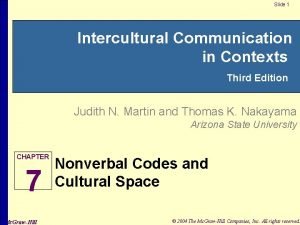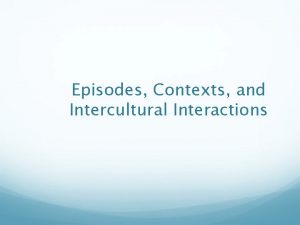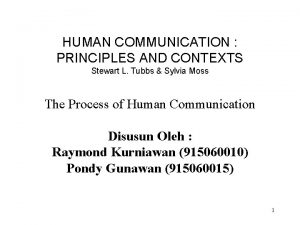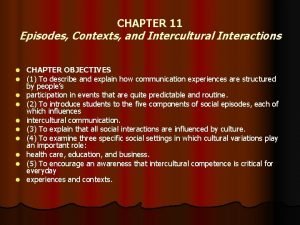Episodes Contexts and Intercultural Interactions Social Episodes in


















- Slides: 18

Episodes, Contexts, and Intercultural Interactions

Social Episodes in Intercultural Relationships Social Episodes are interaction sequences that are repeated over and over again. People’s interactions are structured by their repeated participation in events or social episodes that are quite predictable and routine. The nature of social episodes varies from culture to culture. In social episodes that include intercultural interactions, participants will have very different expectations and interpretations about people’s behaviors and intentions.

Components of social episodes Cultural patterns Social roles Rules of interaction Interaction scenes Interaction contexts

Components of social episodes Cultural patterns are the shared judgments about what the world is, what it should be, and the widely held expectations about how people should behave. Cultural patterns are like tinted glasses that color everything people see and to which they respond. The episodes that structure people’s lives –are common to many cultures; however, the interpretations that are imposed on these behaviors can vary greatly from one cultural group to another due to differences in cultural patterns.

Components of social episodes Social roles are sets of expected behaviors that are associated with people in a particular position. Common social roles include that of student, mother, father, brother, sister, boss, friend, and employee. The role that you take in a particular social episode strongly suggests to you the way in which you should act. In many episodes, you play clearly defined roles that give you guidance about what you should say to the other person and even how you should say it. The role you are playing is matched by the roles of others in the episode. Even though you may think you are fulfilling a particular role, the expectations of the role may vary widely between your culture and the culture in which you are interacting.

Components of social episodes Rules of interaction provide a predictable pattern or structure to social episodes and give relationships a sense of coherence. These rules are not written down, nor are they typically shared verbally; instead, they operate at the level of unwritten, unspoken expectations. Most of the time, people are not consciously aware of the rules that govern a social episode until they are broken. Rules of interaction include such diverse aspects as what to wear, what is acceptable to talk about, the sequence of events, and the artifacts that are part of the event.

episodes Interaction scenes are made up of the recurring, repetitive topics that people talk about in social conversations. Many cultures share a standard set of scenes or topics used to initiate and maintain conversations, and the conversations flow from beginning to end in a more or less predictable pattern. The actual topics in a interaction scene can vary widely from one culture to another. Difficulties can arise in intercultural interactions when the participants differ in their expectations of interaction scenes.

Components of social episodes Interaction contexts are the settings or situations within which social episodes occur. Contexts compose a “frame” or reference point around communication experiences by helping people to determine what specific actions should mean, what behaviors are to be expected, and how to act appropriately and effectively in a particular interaction.

Contexts for Intercultural Communication Healthcare context Education context Business context

Contexts for Intercultural Communication The health care context affects doctors, nurses, counselors, and health care workers, as well as patients, families, communities, and cultural groups. Cultural patterns affect how people understand the health care context. 3 general approaches that characterize beliefs about health. The magico-religious or personalistic approach refers to a belief that health and illness are closely linked to uncontrollable supernatural forces (often moral) The holistic or naturalistic approach refers to a belief that humans desire to maintain a sense of harmony with the forces of nature (hot and cold) The biomedical or Western approach refers to beliefs that a person’s health is controlled by biochemical forces.

Contexts for Intercultural Communication Family and gender roles influences on the health care context. Cultural patterns influence the definition of the patient, family responsibilities, ideas regarding medical treatment, and medical interviews. Some cultures believe only the individual being treated should be informed of his or her illness and possible treatments. In many cultures, health care providers are expected to talk about the nature of the illness and its prognosis with family members but not the patient, and the family members make decisions about the nature of the treatment.

Contexts for Intercultural Communication Intercultural competence in the health care context Health care professionals must assume the responsibility of assuring intercultural competence – which requires an understanding of cultural patterns – in order to treat people effectively. However, an individual may or may not share the preferences of his or her cultural group.

Contexts for Intercultural Communication The educational context Participants in educational settings bring with them their cultural backgrounds and patterns. The role of the teacher Teachers come to the classroom carrying with them both their unique personality characteristics and the influences of their culture. Cultures that prefer a more hierarchical relationship between individuals will structure the relationship between student and teacher with greater status differences. Cultural characteristics influence what is considered appropriate and effective communication within the classroom and shapes what is considered to be desirable and undesirable classroom behaviors.

Contexts for Intercultural Communication Intercultural competence in the educational context Creating a constructive learning environment in an age of cultural diversity requires that people be sensitive to different and sometimes competing experiences. The starting point for developing intercultural competence in the educational context is to understand one’s own cultural background. Because the culture of teachers and administrators influence student knowledge and behavior, the educational context has the potential to help or harm students and their families.

Contexts for Intercultural Communication The business context Differences in cultural patterns create widely dissimilar expectations for how a business is structured and what is considered appropriate and effective communication within that business. 4 variations include: Who speaks for the organization? (Single person, or group? ) Who makes decisions for the organization? (Negotiators, or does it bounce back to the board first? ) What motivates employees? (Individual rewards, or group support? ) What is the basis for the business relationship? (Title /resume, or trust built over a long interpersonal relationship? )

Contexts for Intercultural Communication Intercultural competence in the business context When working in multicultural and international groups, increased attention and effort in the following 4 areas is most useful: Gathering information about the multiple perspectives that will inevitably be present. Maintaining flexibility and a willingness to adapt to differing situations, issues, and needs. Building social relationships as well as task cohesion. Clearly identifying and emphasizing mutual long-term goals.

Episodes, Contexts, and Intercultural Competence Intercultural competence requires an understanding of the episodes and contexts within which interaction occurs. Cultural differences related to episodes and contexts can be a cause of misunderstanding in intercultural interactions.

Discussion Questions What are social episodes? When, if ever, are people affected by them? What are some specific social contexts influenced by culture? What actions can people take to be more interculturally competent in everyday contexts?
 Intercultural communication in contexts
Intercultural communication in contexts The sociological perspective stresses that
The sociological perspective stresses that Social episodes are
Social episodes are Shape matching and object recognition using shape contexts
Shape matching and object recognition using shape contexts Model komunikasi tubbs dan moss
Model komunikasi tubbs dan moss Shape matching and object recognition using shape contexts
Shape matching and object recognition using shape contexts Qualities behaviors and complexities
Qualities behaviors and complexities Professional context examples
Professional context examples Writing in academic contexts
Writing in academic contexts Teachers in crisis contexts
Teachers in crisis contexts The srs document is useful in various contexts:
The srs document is useful in various contexts: Ib global contexts
Ib global contexts Accounting information system chapter 1
Accounting information system chapter 1 Flowers for algernon characterization
Flowers for algernon characterization Jonathan schultz jenny jones
Jonathan schultz jenny jones Who is quaver
Who is quaver Bulimia vs anorexia usmle
Bulimia vs anorexia usmle Parade's end episodes
Parade's end episodes The daily episodes from
The daily episodes from

































